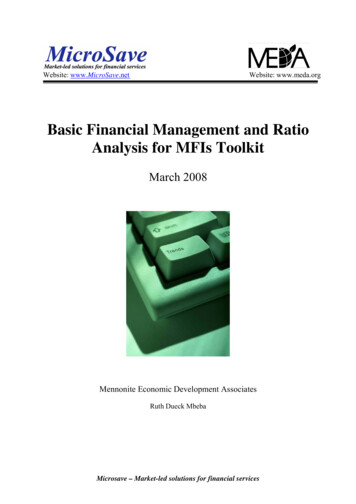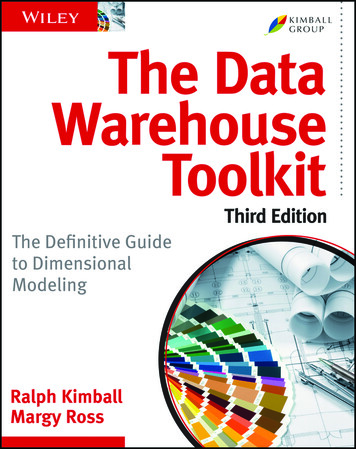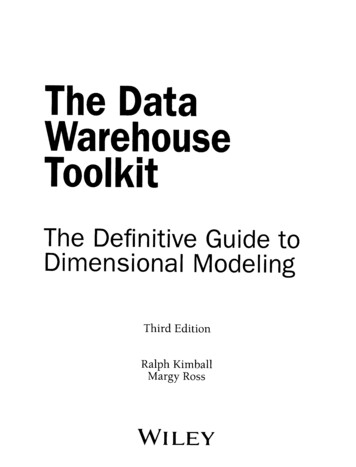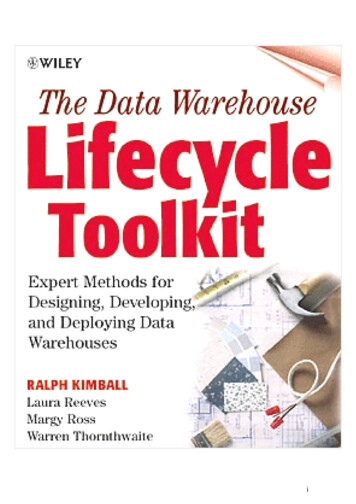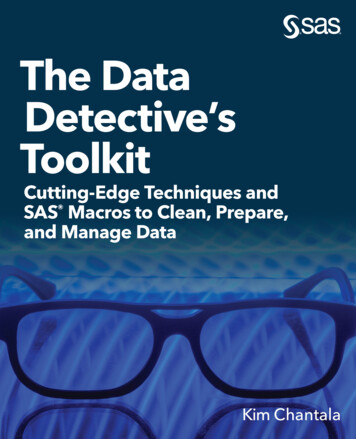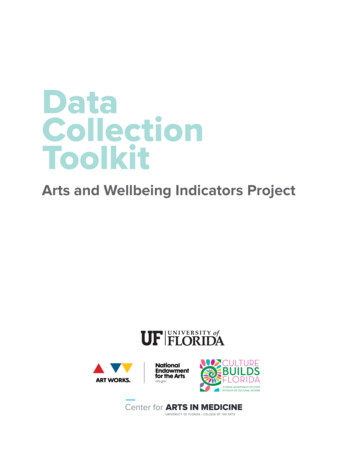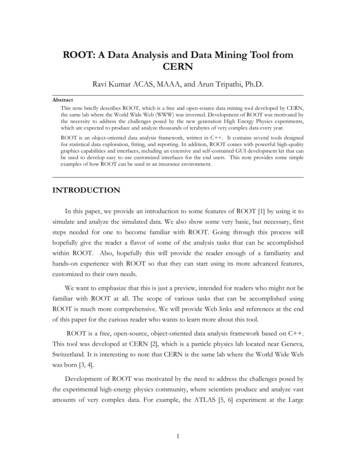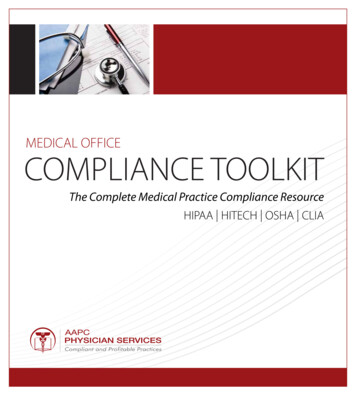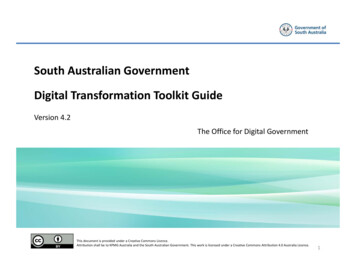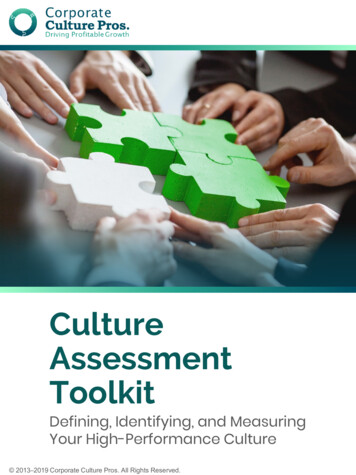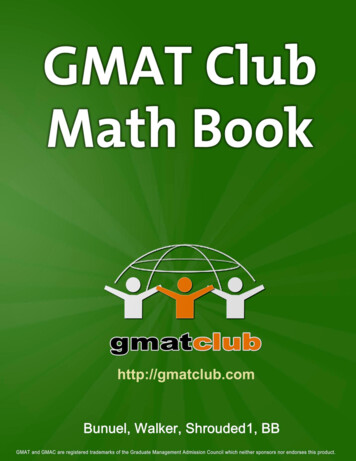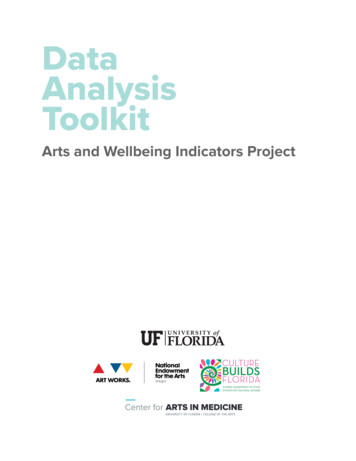
Transcription
DataAnalysisToolkitArts and Wellbeing Indicators Project
Table of ContentsIntroduction . . . . . . . . . . . . . . . . . . . . . . . . . . . . . . . . . . . . . . . . . . . . . . . . . .Materials Needed . . . . . . . . . . . . . . . . . . . . . . . . . . . . . . . . . . . . . . . . . . . . .Data Management in SAS . . . . . . . . . . . . . . . . . . . . . . . . . . . . . . . . . . . . .Inclusion Criteria . . . . . . . . . . . . . . . . . . . . . . . . . . . . . . . . . . . . . . . . . . . . . .Data Cleaning Procedures . . . . . . . . . . . . . . . . . . . . . . . . . . . . . . . . . . . . .Logistic Regression Model Building Process in SAS . . . . . . . . . . . .Linear Regression Modeling in SAS . . . . . . . . . . . . . . . . . . . . . . . . . . . .Limitations to Analyses . . . . . . . . . . . . . . . . . . . . . . . . . . . . . . . . . . . . . . . .Appendix A. Questions and Constructs . . . . . . . . . . . . . . . . . . . . . . . .Appendix B: Example of Data Dictionary . . . . . . . . . . . . . . . . . . . . . .Appendix C. Example of Data Management Flowchart . . . . . . . . .Data Analyses Resources . . . . . . . . . . . . . . . . . . . . . . . . . . . . . . . . . . . . . .34556791011141516
IntroductionThe State of Florida Division of Cultural Affairs has partnered with the University of Florida Center forArts in Medicine on the three-phase project to develop a set of indicators for associating the arts withwellbeing at the community level. The Arts and Wellbeing Indicators project supports the Division’sstrategic goal of promoting healthy, vibrant, and thriving communities.The mission of the State of Florida Division of Cultural Affairs (DCA), as stated in its strategic plan for2015-2020, is to “Advance, support, and promote arts and culture to strengthen the economy andquality of life for all Floridians.” Further, the plan asserts a goal to “promote healthy, vibrant, thrivingcommunities”. The Arts and Wellbeing Indicators project is a step toward strengthening that mission,and a step toward documenting that Florida’s investments in the arts have positive health impacts onFlorida’s communities. This work aligns with the DCA’s commitment to advancing arts and culture inthe State of Florida and makes it possible to provide important data to arts advocates and arts organizations in keeping with its strategic goal to “collect, distill, and disseminate current information thatadvances arts and culture in Florida.”The Arts and Wellbeing Indicators model is a tool for assessing the associations between arts participation and wellbeing in communities. It is important to note that association is distinct from correlation or causation, and that the Indicators model does not identify a direct cause and effect relationship between arts participation and wellbeing. The model includes the primary domains of wellness,arts, and community. Wellness encompasses health and quality of life; the arts domain encompassesparticipation, access, value, infrastructure, and investment; and the domain of community encompasses civic involvement, satisfaction with leadership, openness, safety, social capital, and satisfactionwith community.A single 24-question survey, which takes an average of 10 minutes to complete, was developed toassess each of the model’s variables. Over the project’s second and third phases, the survey wastested in nine Florida counties. An array of surveying methods, including paper and pencil, telephoneand electronic methods, were tested and assessed for cost-effectiveness. The project also assessedand tested the reliability of survey outcomes, with overall findings confirming positive associationsbetween arts participation and wellbeing, and the feasibility of the instrument for assessing theseoutcomes.This toolkit is designed to guide management and analysis of Arts and Wellbeing Indicators survey data. This toolkit follows from the Arts and Wellbeing Indicators Survey Data Collection Toolkit.This toolkit will provide guidance for how to manage and analyze the survey data in SAS (StatisticalAnalysis Software). This toolkit also provides resources on how to read and interpret SAS output. Thistoolkit is intended for those who have experience in statistical programming and analyses (e.g., dataanalyst, statistician, etc.)3
This toolkit provides step-by-step guidance on how to do a variety of data analyses used after collecting data concerning the Arts and Wellbeing Indicators survey. These analyses answer the followingquestions: What are the demographics of those who completed the Arts and Wellbeing Indicators survey? What are the differences between those that participate in formal arts versus informal artsversus no participation? How do you assess aesthetics, civic involvement, leadership, openness, social capital, and safetyin communities and how do they associate with arts participation?Materials Needed After data collection, datasets should be downloaded from whichever data managementsystem has been used (SurveyMonkey, Qualtrics, etc.).o The recommended format is in excel: csv file.o If you are using multiple modes of data collection: It is recommended to stratifydatasets depending on data collection mode. For example, if the data is collected onpaper, this should be separated by file or category, from data collectedelectronically. Data Dictionary/Data Codebook and SAS codeso Please see Appendix A for how the indicators group into constructs.o Please see Appendix B for an example of a data dictionary.o The files needed also include the Codebook, Data Management SAS code and DataAnalyses SAS code Please note that the SAS codes are based on datasets from Phase III of theArts and Wellbeing survey data collection. It is recommended to alterthese codes to fit your unique datasets and their locations onyour computer.o The SAS codes are also documented step-by-step, from importing datasets from Excel intocreating an analytical dataset and analytical data tables.o All SAS codes and codebooks are available by request by contacting the University ofFlorida Center for Arts in Medicine: cam@arts.ufl.edu. Statistical Programming Softwareo This toolkit is for analyses conducted in: SAShttps://www.sas.com/en us/home.html4
Data Management in SASIf you have several datasets due to different modes of collection, it is recommended to use SAS tomerge your data appropriately. Please refer to the Data Management SAS code.Inclusion CriteriaPlease refer to Appendix C for an example of the inclusion criteria that was implemented for Phase IIIof the Arts and Wellbeing Indicators Survey.In order to build the statistical model, it is important to first conduct some preliminary data cleaningprocedures. It is recommended to verify all respondent data before conducting analyses: Assess all data for missingness. It is recommended to only include observations that have atleast half non-missing responses. In addition to significant missing responses, only include observations that have responses forzip-code of residence (question three on the survey), especially if the research question is focusedon county or site-specific population.o Ensure that the zip-codes are within Florida and your area of interest(i.e. county). Please refer to the Data Management SAS code, which merges the Florida zipcode spreadsheet (Florida Zip Codes by City and County.xlsx) with the survey dataset. Include observations that have responses for arts participation (question 21 9 and 21 10 onthe survey)o These questions are used to create the predictor variable of arts participation. Include observations that have responses for all of the following demographics: age, gender,marital status, race/ethnicity, education and incomeo These demographics are important to characterize the sample that is being surveyed.5
Data Cleaning Procedures1. In preparing to undergo statistical modeling, it is required to understand the variations in each ofthe variables. For this purpose, frequencies for all variables would have to be calculated. These variables include participation in the arts, self-reported health indicators measuredthrough the standardized measures (PROMIS Global Short Form and the Short Flourishing Scale),the community vitality indicators (Aesthetics, leadership, openness to diversity, social offerings,civic involvement, social capital, safety) and socio-demographic variables (age, gender, race, ethnicity, education, income, and zip code). This univariate descriptive data allowed you to find errors in data entry (such as erroneous numbers for the variables). This step also allowed you to understand if there were any variables that displayed unusual orinteresting variations. For instance, in the Phase III analyses, some of the items were assessed asyes vs. no while other questions were assessed with a Likert scale where respondents had to ratefrom very good/ good/ neither good or bad/ bad/ very bad such as those in the aesthetics andopenness variables. Researchers can get a general understanding of the data and where to consolidate responsesby running a univariate analysis. If it is found that these categories have few responses ( 5), it issuggested to collapse categorical responses (i.e. very good and good neither good or bad badand very bad)2. Based on the prior steps, creation of new variables based on those already assessed is possible. Forexample, in Phase III, there are two questions to assess for arts participation—one for formal and onefor informal arts participation. A new variable was created that reflect: Participation in both the formal and informal artsParticipation in formal arts onlyParticipation in informal arts onlyNo participation in any arts activityThis will allow you to assess whether respondents had participated in various types of art forms witha single variable.3. If standardized assessments are used, it is required that the calculation provided in the scoringguide of the assessment be strictly followed. For Phase III, based on the coding guide provided forthe standardized tools, calculation of the total Physical health and total mental health (PROMIS scale)scores was carried out. Similarly, it is recommended to calculate total well-being score for the ShortFlourishing Scale as given.6
Logistic Regression Model Building Process in SAS1. If new variables are created, bivariate descriptive analyses (i.e. frequencies, chi-square and t-tests)need to be run to check if the newly created variables show any unusual variations. Additionally,cross tabulations between the predictor variables and the outcome variable and other variablesshould be conducted to arrive at an insight into the bivariate relationships between any two variables. For example, it is recommended to conduct bivariate analyses for the newly created arts participation variable and the socio-demographic variables of interest such as race, gender, age etc. Thiswould guide in understanding if and why certain variables would lose significance in the logisticregression model. Individual variables and the arts participation should be cross-tabulated following which chi-squares (for categorical variables) and t-tests (for continuous variable of age)were used to identify factors significantly associated with informal or formal arts participation inthe last 12 months.i. In Phase III, sampling occurred across different methods (paper, electronic) and in differentcounties. It is important to account for complex survey procedures (e.g. accounting for stratification using PROC SURVEYFREQ and PROC SURVEYMEANS in SAS). For example (as programmed in the Data Analyses SAS code):7
2. Then, predictors of interest can be classified into theoretically distinct groups. By building themodels within those groups first, it will enable researchers to view how related variables work together. For instance, in Phase III, the objective was to understand whether participation in the artswas associated with health and well-being among those across Florida. Potential sets of variablesincluded: Demographics (age, education, race, gender, socio-economic status) Arts participation (informal, formal, both formal and informal) Community vitality indicators (aesthetics, leadership, openness to diversity, social offering’s,civic involvement, social capital, safety)Note: Often, as seen in Phase III, the variables within a group are correlated, but not so much acrossgroups. If everything is included in the model at once, it is hard to find any relationships. Therefore, eachgroup could be built separately first, followed by building theoretically meaningful models with a solidunderstanding of how the pieces fit together.3. In the model building process, bivariate logistic regression models have to be conducted to calculate unadjusted odds ratios between each (or each of the main) main outcome variable(s) and othervariables of interest. In Phase III, bivariate logistic regression analyses were conducted for the community vitalityindicators (aesthetics, leadership, openness to diversity, social offering’s, civic involvement, socialcapital, and safety) and demographic covariates (age, education, race, gender, socio-economicstatus) and the outcome variable of arts participation as described earlier. For reference, a standard approach to model building can be applied (please see the DataAnalyses Resources section of the toolkit); only those variables in univariate models which werestatistically associated (at p-value 0.05) with the outcome variable should be retained in themodel building process.4. Then, multiple logistic regression models would have to be conducted to explore factors associated with the outcome variable and the predictor variables. In Phase III, arts participation was a fourlevel variable, therefore, no participation in any art activity in the past 12 months was the referencegroup for participation in informal arts only in the past 12 months, for participation in formal artsonly in the past 12 months and participation in both formal and informal arts activities in the past 12months. In the multiple (multivariable?) model, variables are required to be entered following an orderbased on the researchers need as well as variables found to be of significance in prior studies.In Phase III, variables were included in the following order: socio-demographics, health variablefollowed by community vitality indicators. Assessment of multi-collinearity was carried out toidentify highly associated independent variables before their inclusion into the models.8
Variables known to be highly correlated should be inserted into the models independently, andretained when found to be significant when controlling for other covariates. Following the inclusion of each variable, the decision to either drop or retain a variable shouldbe based on whether its coefficient differed significantly from 0 (adjusting for the effects of theother variables), whether removal of the variable altered the remaining coefficients of other termsin the model by more than 20% and considering change in the overall fit of the model was improved by its addition. In some cases, a variable is retained in a model for statistical significancebut later can be insignificant when other variables were dropped. In these few cases, the variablethat became insignificant is retained in the model.5. When reporting results of the crude and adjusted multiple logistic regression analyses, adjustedodds ratios (aORs) with 95% confidence intervals (95% CI) are to be reported.Linear Regression Modeling in SASGiven the research question, it may be beneficial to conduct multiple linear regression. If this is ofinterest, it is recommended to create a dummy variable of the four-level arts participation variable inorder to assess the linear relationship between arts participation and PROMIS global physical healthscore, PROMIS global mental health score, and Short Flourishing Score. Similar to the logistic regression model building process, these linear regression analyses couldonly include indicators that are significantly different across levels of arts participation. Thereferent group is no participation in the arts in the last 12 months. When reporting results of the crude and adjusted multiple linear regression analyses, betaestimates, p-values and model R-squares are appropriate to report. Please see below for anexample of a data table.crudeadjusted*Adjusted (including all art participation groups)βPModel R2βPModel R2βPNo refrefInformal Arts Participation Formal Arts Participation Both Informal and Formal Arts 640.0003Model R2Global Physical Health*Adjusted for: Gender, Age, Race/Ethnicity, education, income, and health checkup in last 12 months90.05239
Limitations to AnalysesSample Size and PowerPlease note that if the sample size is smaller, this would cause underpowered analyses. Issues withpower will produce models not able to detect association between arts participation and otherindicators. A smaller sample also means limited adjusted models. With an increase in sample, moreparameters (variables) are able to be added to regression modeling.10
Appendix A. Questions and ConstructsConstruct Survey QuestionsWellness In general, would you say your health is: In general, how would you rate your physical health? In general, how would you rate your mental health, includingyour mood and your ability to think? In past 7 days: How often have you been bothered by emotionalproblems such as feeling anxious, depressed, or irritable? In past 7 days: How would you rate your fatigue (tiredness)on average? In past 7 days: How would you rate your pain on average?Access to Care Do you have health insurance right now? The availability and accessibility of quality healthcareHealthcare Utilization Have you had a routine physical examinations or healthcheck-up in the past twelve months?Quality of Life In general, would you say your quality of life is: In general, how would you rate your satisfaction with your socialactivities and relationships? In general, please rate how well you carry out your usual socialactivities and roles. To what extent are you able to carry out your everyday physicalactivities such as walking, climbing stairs, carrying groceries,or moving a chair?Short Flourishing Scale I lead a purposeful and meaningful life My social relationships are supportive and rewarding I am engaged and interested in my daily activities I actively contribute to the happiness and well-being of others I am competent and capable in the activities that are important to me I am a good person and live a good life I am optimistic about my future People respect meArts and Wellbeing Indicators Original Questions Do you think that the arts or creative activity currently contributes toyour personal quality of life? Do you think that the arts or creative activity currently contributes toyour community’s quality of life?11
ArtsParticipationArts and Wellbeing Indicators Original Questions Attended any art activity in community in last 12 months Participated in any hands-on creative activity in last 12 months Participated in any recreational activities in last 12 months Approximately how many times in the past (30 days, twelve months)have you attended any arts activity in or near your community? Approximately how many times in the past (30 days, twelve months)have you participated in these hands-on creative activities? Approximately how many times in the past (30 days, twelve months)have you attended these recreational activities?Access The availability and accessibility of arts and cultural opportunities,such as theater, museums, and musicValueInfrastructureInvestment AEP V DataCommunityCivic InvolvementWhat
The Arts and Wellbeing Indicators model is a tool for assessing the associations between arts partici-pation and wellbeing in communities. It is important to note that association is distinct from correla- . ing data concerning the
